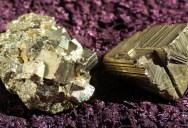Here’s How You Know If You’ve Struck Gold Or Just The Fool’s Version

Fool’s gold (pyrite) is aptly – if not very kindly – named.
That’s because it’s pretty tough to tell which is which just by looking!
There are some telltale signs to look for though, so you should be able to stop nature from duping you in the future.
Pyrite is a common crystalline iron sulfide mineral that’s virtually worthless. Much like real gold, though, it’s found in small crystals in soil and sediment.
The result of a reaction between sulfide and iron, it can appear as gold, silver, chrome, or a wide array of other colors.

People do use it to make more affordable versions of jewelry and ornaments, but if you can’t tell which is which, you could pay the price of gold but get the fool’s version in return.
There are a few ways to tell the difference if you don’t care about the integrity of the specimen – you’ll have to destroy it to analyze it.
First, you could use Moh’s test for hardness, which is a scale used to identify a hardness number based on what materials are able to scratch it.
Pyrite has a hardness score of 6, while gold scores much lower, at 2.5.
Next is sectility, which is the ability to cut the material with a sharp knife. You won’t get anywhere with the pyrite, but small portions of gold can be cut.
Then there’s ductility, which is how easily it can be bent. Gold is malleable under pressure, which means it’s easy to bend and dent without breaking.
Pyrite will not be affected at all.
Lastly, a streak test is done by scraping a specimen across unglazed porcelain. The color of the residue is the “streak,” and a yellow one indicates real gold.

Pyrite would leave a black, green, or brown residue.
There are a few ways you could try and make the distinction without potentially damaging your specimen.
The first is a simple color test. It can be a bit tricky, but pyrite tends to be more brassy than pure gold. Also, gold found in nature can be alloyed with silver, making it appear the slightest bit white.
Their shapes are a bit different as well, with gold being more smoothed and pyrite having more angular edges. It can be tough to really say for sure, though.
Pyrite should have lines called striations running across the surface, and gold does not.
In addition, pyrite will tarnish easily with exposure to a natural environment, but gold should remain shiny.

Perhaps the two easiest ways to tell the difference are magnetism – pyrite will be attracted to a magnet and gold will not – and smell.
Pyrite stinks like rotten eggs!
Have fun hunting, and good luck.
Remember not to play the fool if you pick up some pyrite.
If you thought that was interesting, you might like to read a story that reveals Earth’s priciest precious metal isn’t gold or platinum and costs over $10,000 an ounce!

Sign up to get our BEST stories of the week straight to your inbox.




